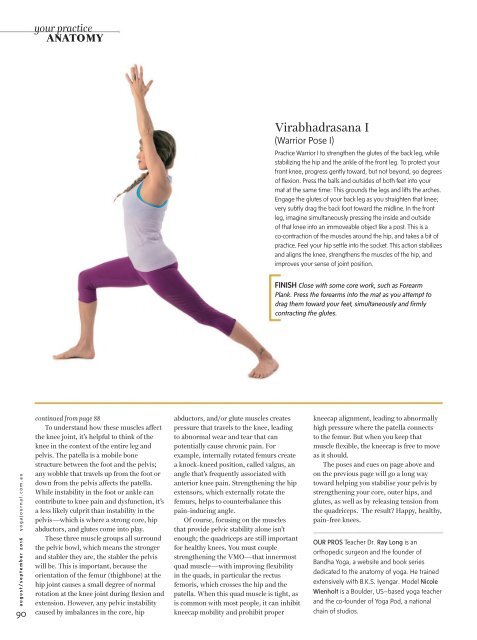Australian_Yoga_Journal_2016_08_09_downmagaz.com
You also want an ePaper? Increase the reach of your titles
YUMPU automatically turns print PDFs into web optimized ePapers that Google loves.
your practice<br />
ANATOMY<br />
Virabhadrasana I<br />
(Warrior Pose I)<br />
Practice Warrior I to strengthen the glutes of the back leg, while<br />
stabilizing the hip and the ankle of the front leg. To protect your<br />
front knee, progress gently toward, but not beyond, 90 degrees<br />
of flexion. Press the balls and outsides of both feet into your<br />
mat at the same time: This grounds the legs and lifts the arches.<br />
Engage the glutes of your back leg as you straighten that knee;<br />
very subtly drag the back foot toward the midline. In the front<br />
leg, imagine simultaneously pressing the inside and outside<br />
of that knee into an immoveable object like a post. This is a<br />
co-contraction of the muscles around the hip, and takes a bit of<br />
practice. Feel your hip settle into the socket. This action stabilizes<br />
and aligns the knee, strengthens the muscles of the hip, and<br />
improves your sense of joint position.<br />
FINISH Close with some core work, such as Forearm<br />
Plank. Press the forearms into the mat as you attempt to<br />
drag them toward your feet, simultaneously and firmly<br />
contracting the glutes.<br />
august/september <strong>2016</strong> yogajournal.<strong>com</strong>.au<br />
90<br />
continued from page 88<br />
To understand how these muscles affect<br />
the knee joint, it’s helpful to think of the<br />
knee in the context of the entire leg and<br />
pelvis. The patella is a mobile bone<br />
structure between the foot and the pelvis;<br />
any wobble that travels up from the foot or<br />
down from the pelvis affects the patella.<br />
While instability in the foot or ankle can<br />
contribute to knee pain and dysfunction, it’s<br />
a less likely culprit than instability in the<br />
pelvis—which is where a strong core, hip<br />
abductors, and glutes <strong>com</strong>e into play.<br />
These three muscle groups all surround<br />
the pelvic bowl, which means the stronger<br />
and stabler they are, the stabler the pelvis<br />
will be. This is important, because the<br />
orientation of the femur (thighbone) at the<br />
hip joint causes a small degree of normal<br />
rotation at the knee joint during flexion and<br />
extension. However, any pelvic instability<br />
caused by imbalances in the core, hip<br />
abductors, and/or glute muscles creates<br />
pressure that travels to the knee, leading<br />
to abnormal wear and tear that can<br />
potentially cause chronic pain. For<br />
example, internally rotated femurs create<br />
a knock-kneed position, called valgus, an<br />
angle that’s frequently associated with<br />
anterior knee pain. Strengthening the hip<br />
extensors, which externally rotate the<br />
femurs, helps to counterbalance this<br />
pain-inducing angle.<br />
Of course, focusing on the muscles<br />
that provide pelvic stability alone isn’t<br />
enough; the quadriceps are still important<br />
for healthy knees. You must couple<br />
strengthening the VMO—that innermost<br />
quad muscle—with improving flexibility<br />
in the quads, in particular the rectus<br />
femoris, which crosses the hip and the<br />
patella. When this quad muscle is tight, as<br />
is <strong>com</strong>mon with most people, it can inhibit<br />
kneecap mobility and prohibit proper<br />
kneecap alignment, leading to abnormally<br />
high pressure where the patella connects<br />
to the femur. But when you keep that<br />
muscle flexible, the kneecap is free to move<br />
as it should.<br />
The poses and cues on page above and<br />
on the previous page will go a long way<br />
toward helping you stabilise your pelvis by<br />
strengthening your core, outer hips, and<br />
glutes, as well as by releasing tension from<br />
the quadriceps. The result? Happy, healthy,<br />
pain-free knees.<br />
OUR PROS Teacher Dr. Ray Long is an<br />
orthopedic surgeon and the founder of<br />
Bandha <strong>Yoga</strong>, a website and book series<br />
dedicated to the anatomy of yoga. He trained<br />
extensively with B.K.S. Iyengar. Model Nicole<br />
Wienholt is a Boulder, US–based yoga teacher<br />
and the co-founder of <strong>Yoga</strong> Pod, a national<br />
chain of studios.


